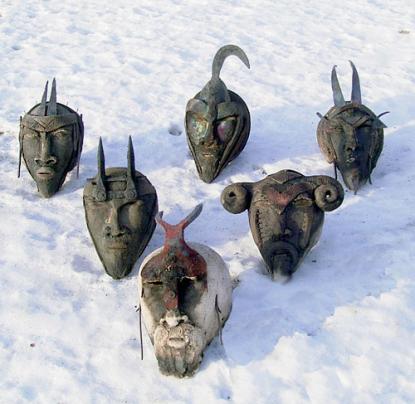2025. April 17. Thursday
Géza Gorka Ceramics Museum - Verőce
 |
Address: 2621, Verőce Szamos utca 22.
Phone number: (30) 717-7206
E-mail: gorkamuzeum@veroce.hu
Opening hours: 01.04 - 31.10.: Fri 9-13, Sat-Sun 10-16, Mon-Thu: only on prior notice, 01.11 - 31.03: only on prior notice
|
The exhibition has closed for visitors.
2006.04.22. - 2006.06.18.
Museum tickets, service costs:
|
Ticket for adults
|
600 HUF
|
|
|
Ticket for students
|
300 HUF
|
|
|
Ticket for pensioners
|
300 HUF
|
|
|
Group guide
|
4000 HUF
|
/ group
|
|
Group guide for students
|
2000 HUF
|
/ group
|
Bereczki Katalin has been attracted to ancient cultures ever since the beginning of her career. The first time she managed to travel to the Hopi Indians was in 1993 and has returned every year since. The next year she traveled to the Dogon tribe, to Africa and to the Republic of Mali.

One of the greatest experience of her life was working with the potter women of Africa who worked with the poorest equipment but still created the most perfect pieces. They know how to tend the surface and how to burn them dry. Katalin mined the raw material together with them; he watered it and works it with his hands and feet. She gains a lot of the relation just as the hosts do. She builds furnaces of clay that are apt for cooking, baking too. The potters do not know either the potter's wheel or the furnace we do. She has been traveling in Africa ever since fulfilling many invitations to build clay furnaces.
The spirituality she gained through her traveling shows in her works. She often burns objects with a large amount of fire-clay with raku-enamel. It is a process through which the metal oxides reformed into metal and form a shiny layer that is unlike anything else.
Probably the most exciting pieces of the exhibition are the masques made of the combination of metal and fire-clay. The dance of the black people which cannot be performed without a masque, influenced Katalin greatly. Masques have a symbolic meaning through which the dancers can identify with the creature whose masque they wear. Thus, the ugly may become nice and vica versa. The heads Katalin makes remind us of the masques of the shamans or the face of the knight in the armour in the Middle Ages.
The functional dishes, statues and symbolic objects are also part of her colorful oeuvre. In representing symbolic objects, she understood the most elementary and pure forms, just as the perfect pebbles.
At her exhibition in Verőce she shows the pieces influenced by people of nature. These pieces are just as familiar in the home of the Gorka family as ceramics.
Köpöczi Rózsa

One of the greatest experience of her life was working with the potter women of Africa who worked with the poorest equipment but still created the most perfect pieces. They know how to tend the surface and how to burn them dry. Katalin mined the raw material together with them; he watered it and works it with his hands and feet. She gains a lot of the relation just as the hosts do. She builds furnaces of clay that are apt for cooking, baking too. The potters do not know either the potter's wheel or the furnace we do. She has been traveling in Africa ever since fulfilling many invitations to build clay furnaces.
The spirituality she gained through her traveling shows in her works. She often burns objects with a large amount of fire-clay with raku-enamel. It is a process through which the metal oxides reformed into metal and form a shiny layer that is unlike anything else.
Probably the most exciting pieces of the exhibition are the masques made of the combination of metal and fire-clay. The dance of the black people which cannot be performed without a masque, influenced Katalin greatly. Masques have a symbolic meaning through which the dancers can identify with the creature whose masque they wear. Thus, the ugly may become nice and vica versa. The heads Katalin makes remind us of the masques of the shamans or the face of the knight in the armour in the Middle Ages.
The functional dishes, statues and symbolic objects are also part of her colorful oeuvre. In representing symbolic objects, she understood the most elementary and pure forms, just as the perfect pebbles.
At her exhibition in Verőce she shows the pieces influenced by people of nature. These pieces are just as familiar in the home of the Gorka family as ceramics.
Köpöczi Rózsa
